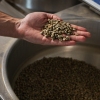A French zarf and cup, made round 1848 to 1855, fabricated from porcelain. Zarfs are sometimes related to espresso ingesting within the Ottoman Empire, however many had been made in Europe.
The Cleveland Museum of Artwork
conceal caption
toggle caption
The Cleveland Museum of Artwork
Does your favourite espresso mug have a humorous pun or cool artwork? Or perhaps an intricate ceramic design?
How about stepping issues up and having some jewellery together with your java?
Enter the zarf, a Turkish phrase that means “envelope.” It refers to ornamental gadgets used particularly through the Ottoman period to carry scorching cups of espresso.
And extra lately it may very well be a time period for these ubiquitous cardboard sleeves that preserve your fingers from overheating. On this version of Phrase of the Week, we delve into espresso’s previous to know the function of the zarf.
Espresso is extra than simply espresso in Turkey

Individuals sit at a espresso store in 2018 in Istanbul. Espresso has an extended custom in Turkey.
Ozan Kose/AFP by way of Getty Photographs
conceal caption
toggle caption
Ozan Kose/AFP by way of Getty Photographs
Espresso is an enormous deal in Turkey and has been for a whole lot of years. The Turkish means of serving espresso has been acknowledged by UNESCO, the United Nations cultural company, for its cultural significance.
Espresso made its means to what’s now Turkey through the Ottoman Empire, at the very least way back to the sixteenth century.
“For the Ottomans, coffee serving was a ritual, and it was also an art form. So it wasn’t just some kind of a coffee drinking ceremony. Everything from the serving, brewing — everything was part of that ritual,” says Gizem Şalcıgil White, the founding father of Turkish Espresso Girl espresso outlets and basis and an evangelist for Turkish espresso.
Getting ready espresso the Turkish means entails grinding the beans very finely, and slowly cooking the water and low in a pot to create a thick layer of froth. It is served in small cups.
That is the place the zarf is available in. “The zarf is actually a handle for these tiny little coffee cups,” White says. “It’s supposed to be functional, but at the same time is the symbol of Ottoman luxury lifestyle. It’s more like, you know, a statement of rank or elegance, sophistication, because Turkish coffee is a cultural treasure for the Ottomans.”
Zarfs have are available numerous varieties, from stripped down steel to intricate floral designs, colourful enamel and punctiliously inlaid jewels.
Cenk Girginol, a Turkish espresso marketing consultant and writer of the e-book Espresso: From the Soil to the Cup, says zarfs started for use on the finish of the seventeenth century and starting of the 18th century.

A Nineteenth century zarf is pictured on the Museum of Islamic Artwork, in Doha, Qatar. The gadgets had been used to carry scorching espresso cups through the Ottoman Empire.
Richard Mortel/Flickr Artistic Commons
conceal caption
toggle caption
Richard Mortel/Flickr Artistic Commons
Zarfs had been typically fabricated from steel, whereas the espresso cup could be fabricated from ceramic or glass, in keeping with the Khalili Collections artwork assortment.
Zarfs might function silver and gold of their development, White says. She says Ottomans would get away the flamboyant zarfs for visiting ambassadors. However strange individuals might additionally use zarfs of their houses, Girginol says in an e-mail.
By the Nineteenth century, goldsmiths in Geneva had been making zarfs to export, in keeping with the Khalili Collections. Current auctions and museum collections present zarfs that had been made in France, Syria, Iran and Switzerland. A zarf within the Louvre’s assortment, lined in emeralds and diamonds, was owned by Abdul Hamid II, the sultan of the Ottoman Empire within the late 1800s and early 1900s.
In English, the phrase “zarf” seems in accounts of vacationers to the Ottoman Empire within the mid-Nineteenth century, says Douglas Harper, editor of Etymonline.com.
“It’s an Eastern exotic product that the Europeans don’t have, but they’re writing about,” he says.
(Though zarfs are sometimes related to Turkey, the phrase is of Arabic origin, in keeping with George Berg, a professorial lecturer in Arabic research at American College, who says “it primarily means container or vessel.” Harper notes that many Arabic-speaking areas had been at sure factors underneath Ottoman rule.)
In the present day, you are unlikely to be served espresso in a elaborate zarf even in historic coffeehouses in Istanbul, White says.

A Swiss colourful enamel music field within the type of a zarf, circa 1840, embellished with rose diamond foliate sprays, with later silver gilt liner.
The Metropolitan Museum of Artwork
conceal caption
toggle caption
The Metropolitan Museum of Artwork
“The zarfs are considered very prestigious presentation, like you cannot just serve it to your customers as an item on your menu. There has to be a ceremony. There has to be a special occasion.”
Nevertheless, she does have zarfs for serving espresso in her outlets within the U.S.
A zarf that is not a zarf

A Starbucks espresso cup is pictured with a cardboard sleeve. Some individuals contemplate the sleeves to be zarfs, however others disagree.
Gene J. Puskar/AP
conceal caption
toggle caption
Gene J. Puskar/AP
Zarf has by no means actually caught on in English, apart from some individuals “who like to show off their vocabulary,” in keeping with Harper, or the occasional crossword puzzle reply.
Nonetheless, some definitions on the web embody a disposable espresso cup sleeve underneath the “zarf” definition.
Jay Sorensen created the Java Jacket in Portland, Ore., within the early Nineties, a model of the now-ubiquitous cardboard espresso cup sleeve. He was the primary to extensively market such a product within the U.S.
The concept got here after he spilled espresso on himself. Polystyrene cups had been banned in Portland, he says, and low was being served in paper cups.
“I went through one of the first gourmet drive-throughs in Portland called Coffee People, and they used to hand it to you with napkins. And I was driving a ’64 Ford pickup, a three speed on the column, and I dropped the cup of coffee in my lap and burnt myself. It wasn’t severe, but that got me thinking,” he says.
He initially toyed with the concept of a double-walled cup earlier than selecting the Java Jacket.
The corporate grew, reaching near a billion items offered in 2016, he says.
Today they’re going through extra challenges. Their patent expired a decade in the past and firms from Asia and Jap Europe are actually “flooding the market.”
And iced espresso is getting extra in style.
“It used to be, cold drinks were basically a summertime phenomena,” Sorensen says. “But now if you look at the statistics, cold has taken up a pretty big portion of all coffee drinks year-round now. So that hurts.”
However again to zarfs. Sorensen says somebody talked about the phrase to him perhaps 30 years in the past.
“I didn’t pay much attention to it, but then it’s popped up many times since then. … I always just thought of it as a word for a coffee holder that, you know, somebody used in Islam hundreds of years ago.”
White is on the identical web page so far as zarfs go. Requested if she would ever name a cardboard sleeve a zarf, she says, “I would not.”
“It has a lot of meaning, it’s not just, you know, a functional holder,” she says. “It’s part of the ritual” of Turkish espresso.
Harper says zarf is “an old word, but a very specialized old word. And the transfer of it to a modern sort of commercial product, people who are familiar with the old thing would sort of roll their eyes at that. And people who aren’t would say, ‘That’s cool, we need a word for that.'”






